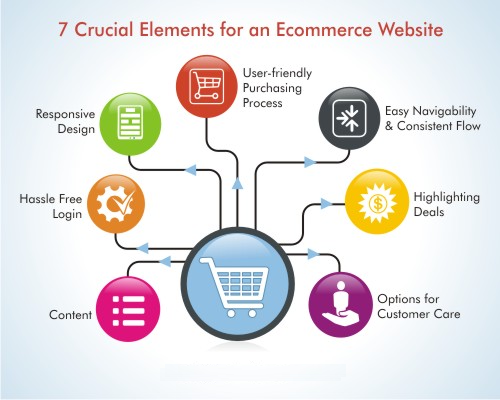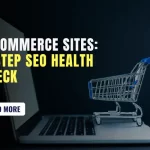SEO for Ecommerce Website: The Definitive Guide
Recently updated: December 7th, 2024
The Covid-19 crisis has now made more people savvy in online shopping. As such, in 2021, a larger section of consumers will be scouring e-commerce sites to fulfil their day-to-day needs. So, now is the best time for businesses to enter the digital world and build an SEO-friendly e-commerce website.
In this guide, we will cover the following topics:
- How is an e-commerce website different from a regular website?
- What makes a successful e-commerce website?
- Why is SEO important for an e-commerce website?
- How to do SEO for an e-commerce website?
Let’s find out.
How Is an E-Commerce Website Different from a Regular Website?
A regular website is simply created to develop your online presence and promote your products and services.
On the other hand, an e-commerce website tends to serve as a platform where your customers can buy your products and services directly practically from anywhere, anytime.
The offerings of an e-commerce website can include digital products such as software, music, images, and infographics; physical products such as clothes, jewelry, footwear, electronic gadgets, appliances, books, and furniture; and services, such as mobile wallets, insurance, tickets, and so on.
What Makes a Successful E-Commerce Website?
The design, look and feel, and various other factors of your site greatly impact whether consumers will want to use it or not.
Here are some of the key attributes that your e-commerce website must have to be successful.

Why is SEO Important for an E-Commerce Website?
Google is deeply embedded in the lives of consumers these days. Whatever they need, they just Google it. Since highly-optimized websites with a good online reputation get a spot among top results most of the time, SEO has become critical to e-commerce businesses.
Ignoring SEO means you are taking the risk of not being visible in front of your target audience. When only a few customers know about you, you make less revenue, and your growth slows down while your competitors enjoy boosted sales and profits.
In short, your SEO strategy for an e-commerce website matters a lot if you want your e-commerce business to grow and thrive.
How to Do SEO for an E-Commerce Website?
You will find countless SEO tactics for e-commerce that claim to produce guaranteed outcomes. But, with a sheer number of SEO tips for e-commerce websites also comes dilemma and confusion about what to consider, where to start, and what brings the best results. Especially if you are a beginner, a guide of ten thousand words can be overwhelming and distracting.
So, here, we are sharing an SEO proposal for e-commerce websites that will help you make a head-start and implement major amendments and enhancements without going too deep in technicalities.
SEO Checklist for E-commerce
- Keyword Research
- Competitive Analysis
- Site Design and Navigation
- On-Page SEO
- Technical SEO
- Local SEO
- Content Marketing
- Internal Links
- Social Share Buttons
- SEO Analysis
A Detailed SEO Plan for E-commerce Websites
Now, let’s check out how to SEO e-commerce websites.
Keyword Research for E-commerce
Keyword research for an e-commerce website slightly differs from traditional keyword research.
While doing SEO for e-commerce websites, you need to:
- Find out and enlist actual keywords that customers search for a specific product or service
- Understand the difference between head keywords, long-tail keywords, and keywords with search intent and then use them accordingly
- Determine the search volume of those keywords
- Explore similar keywords and terms that you can use during content creation, social media marketing, and advertising
How to do keyword research for e-commerce websites?
- Analyze dynamic search ad queries apart from using brand-focused keywords.
- Spy on your competitors to see what keywords they are using.
- Use Pinterest to have an understanding of what semantic phrases are trending for your products or services.
- Extract keywords from the site search query field.
- Check out search field suggestions of other big e-commerce platforms like Amazon.
- Consider user intent when searching keywords for e-commerce website.
- Check for keyword trends by date and season because search volumes fluctuate all year round.
Competitive Analysis
Performing an in-depth analysis of your competitors’ e-commerce websites not only helps you understand how they are making their customers happy but also gives insight into what needs of customers are unmet through their platform.
Use major platforms such as Google Shopping, Amazon, and Flipkart to quickly detect major competitors in your industry. It will make it easier to establish which online stores in the search results can be considered your direct competitors based on their business model and catalogue.
What should be considered during competitive analysis for e-commerce?
- Detect patterns in the competitive pricing history of rival stores
- See what they are doing to drive their traffic and from where they are getting most of the traffic
- Find out the sources they have earned backlinks from
- Check out their best content, their length, formatting, and types
- See which social media channels they are active on
- Analyze how they interact with their followers and customers
- Check their current Facebook posts and ads
- Observe how they demonstrate their products and services
- Check out the number of images they use per product and the information provided for it
- See if they are using a plain white background for product images or being creative while showing their products
- Analyze their site design, navigation, flow, steps to complete the checkout, and placement of CTAs, menus, and shopping cart
- Analyze their return policy and messaging as well
Site Design and Navigation
Simply creating an e-commerce website is not enough. Every detail right from the menu, product categories, product pages, and responsive product images to contact forms, return policy pages and checkout pages can influence the decision of a buyer.
Here are a few tips to enhance your site design and navigation in a manner that artfully serves customers as well as the SEO purpose.
- Get a second opinion to know if your website is really user-friendly, easy to use and navigate, and has visual appeal
- Don’t go for flashy websites that create lots of distractions for users. Minimalist websites with some creativity are consistently rated as more appealing and trustworthy.
- Make the menu bar appear across all the pages for utmost ease. Don’t load it with too many categories.
- Keep the shopping cart and wishlist buttons visible on all pages so that they can easily see what they are buying or intend to buy later.
- Keep your products organized into specific categories to streamline the search process.
- Make pricing structure transparent. Be upfront about the tax (if it is inclusive or exclusive), delivery charges, or any other charges you are adding to the total cost.
- Make sure your customers can see the total cost including the shipping fee before making a purchase.
- Fairly mention the shipping date estimate to make it easier for your customers to make purchase decisions.
- Clearly mention the payment options you offer
- Don’t display a pop-up window for newsletter subscriptions or anything irrelevant when a customer is about to make a purchase.
- Include reviews and testimonials because the majority of online shoppers read them before making a purchase.
- Highlight if a product stock is getting depleted because it sends the message that the product is trending.
- Don’t forget to include a search bar near the top of your site.
- Make contact information easy to find.
On-Page SEO
On-page SEO is critical for e-commerce websites because they consist of several product pages. Since people will be making monetary transactions, you must use HTTPS protocol for your online store. It will not only help you gain credibility in the eyes of your customers but also Google.
While product-oriented keywords are obligatory, smart e-commerce site owners also embed buyer intent keywords in their product descriptions, title tags, and meta descriptions.
Delete duplicate content from the site to avoid getting flagged and generic descriptions that don’t inspire sales. Craft unique, purchase-oriented content that highlights the attributes of a product and tells how it solves their problems or caters to their wants.
Show product reviews on relevant product pages but don’t limit their presence to product pages only. Implement review snippets enabled by schema markup so that search engines can crawl and pull specific information from a website to display within search results for a better user experience.
Speed up the loading time of your e-commerce site; otherwise, all the efforts are going to be undone. We know it’s much harder as your web pages are going to be loaded with images and videos.
To boost page loading speed, you can try the following:
- Premier hosting services
- Optimized server configurations
- Image and video compression
- De-clutter by removing unnecessary elements
Technical SEO
Technical SEO refers to the SEO that is directly related to your website design and construction. It is the part that involves dealing with your code base.
How to perform technical SEO for E-commerce Websites?
- Make the site structure in a way that makes the products/services easily accessible. Ideal e-commerce site structure should be: Homepage > Categories > Subcategories > Product
- For small e-commerce websites, you can avoid creating subcategories.
- Make URL structure clear, meaningful, and consistent so that it depicts what page it exactly belongs to. Follow the hierarchy and use hyphens instead of underscores to separate words.
- While HTML sitemaps help users navigate the platform with ease, XML sitemaps allow search engine bots to properly index URLs throughout the website. Choose accordingly based on what matters to you more.
- Check log files to analyze information about every interaction with your website – bot or human.
- Use canonical tags for situations when product pages are reachable from multiple categories. It helps you tell the search engine which version of the URL should be crawled and shown in search results.
- Use Robot.txt files for pages that should not be crawled by search engine bots
- Fix errors, such as 3xx, 4xx, and 5xx because these codes are important to measure the health of your e-commerce website and SEO.
- Make your e-commerce website responsive to mobile devices.
Local SEO
As with any local business, it pays to create a profile on Google My Business for your e-commerce business. Provide as much information as you can. Add business name, address, phone number, operating hours, services, images, and website URL accurately.
If you serve in multiple locations, then include them all on your website. Create content keeping the locality of your customers in mind. Get reviews, ratings, or feedback from your current buyers as they send a positive signal to search engines.
Create backlinks through local business groups, local news websites, review websites, and blogs of local friends/customers/social influencers.
Content Marketing
Create guides on how to use, fix, or assemble a particular product. DIY Guides to solve petty issues at home are also highly appreciated by your customers. Don’t use these guides to sell. Let these guides show your customers that you genuinely care about them. If possible, include visuals in the content for better understanding.
You can also create video content that can act as short ad campaigns. Create FAQs to clear common doubts that your customers might have or provide the information they most likely want to know. Share customer stories on your site and your social media channels as well.

You can even provide case studies that demonstrate how your product or service helps your customers.
Internal Links
You can do a great job of internal linking on your e-commerce website with the following steps:
- Create a Brand Landing Page that contains a description of the brand and what products it offers, and then link them all with appropriate categories or products on the site.
- Show Related Items as suggestions on the bottom of a product page.
- List out other brands you offer for similar products. You can call this feature – Related Brands.
- Display Featured Items based on ‘Most Searched For’ and ‘Bestseller Products’ on the homepage or a category page.
- Create blogs about a certain product or topic and then link them to specific products or pages.
- Create buying guides to easily feature premium products on your site.
Social Share Buttons
Twitter, Facebook, and Pinterest are some of the most popular social media share buttons that people use. Apart from this, Instagram and Whatsapp are also among the top choices when it comes to social media sharing. At times, people like to show what they are intending to buy and get feedback from their friends and family. This happens a lot when they are buying a gift for someone.
But, where you should add them? What is the best place to add social sharing buttons?
You can add them on blogs/articles/news pages. While some sites may not benefit from adding these buttons on product pages, certain kinds of e-commerce sites may actually enjoy perks. If your products are likely to make someone ‘pin now, look later’ or make their friends feel envious, then you should definitely add them on your product pages. Don’t forget to test the content to see how it looks like after sharing.
SEO Analysis
Performing a regular SEO audit of your e-commerce site will help find why visitors are coming to your site, why they are not clicking on the CTA of a product page, what they are looking for, why so many people are abandoning their shopping carts, and much more.
During analysis, focus on important e-commerce metrics, such as bounce rates, exit rates, average order value, and so on.
Once you know what’s happening on your site, you need to find out why it is happening. For this, you will need a complimentary type of e-commerce analysis, called user-driven analysis.
Here are a few examples of how you can develop a deeper understanding of visitors’ behavior for your e-commerce site:
- Heatmaps to see visually how customers are moving around and clicking on the page
- Session recordings to see how anonymized users got from point A to point B across your site
- Onsite surveys that collect feedback from your visitors when they visit a specific page or perform a specific action
- Feedback widget to allow your site visitors to give candid feedback about your site
The importance of SEO for e-commerce websites has increased because people have got comfortable with shopping online more than ever. This means you should be too. Enabling your customers to buy directly from you is one thing and getting them convinced to select your platform for buying products is another thing. With the right ecommerce SEO Services , you can give search engines more reasons to rank you higher and your customers to choose them over your competitors.
Latest posts by Vijaya Tyagi (see all)
How To Track Shopify SEO Performance & Metrics (2025) - January 14, 2025
Link Building Strategies: The Ultimate Techniques for 2025 - December 31, 2024






